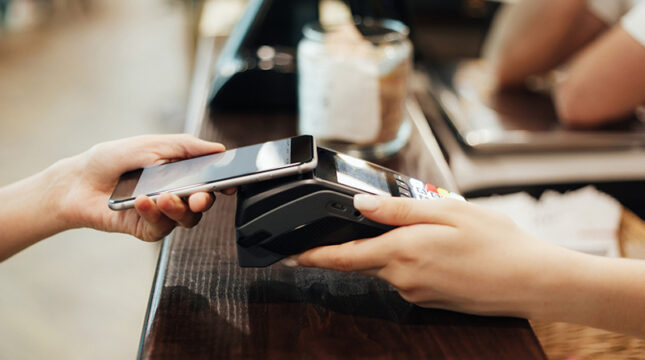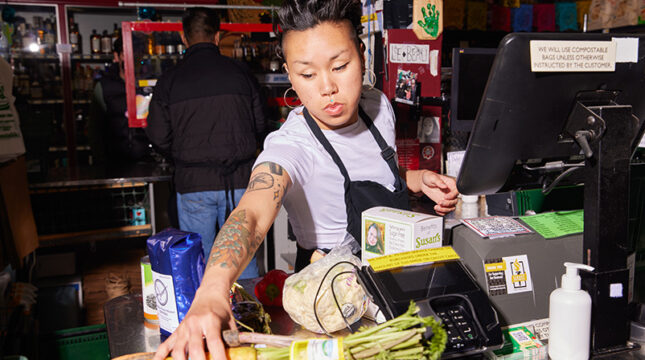Which business owners can benefit from P2P payments?
Most businesses accept credit card payments. Moving to implement peer-to-peer payments can be an excellent option, too. But it might not make sense for some industries or lines of work.
For example, you’d benefit from adding P2P as a payment option if you operate a business that’s constantly on the go.
Think of mobile dog groomers, cleaners, and landscapers. When you’re quickly moving from one client to another, you don’t want the hassle of lugging around a POS (point-of-sale) system.
The same could be true for businesses that don’t need a robust POS system. Let’s say you run a small bakery business or local clothing resale shop. In that case, you might find accepting P2P payments is easier for you and your customers.
How do P2P payments work?
P2P payments work by both parties downloading the app and linking a bank or credit card. The software used to store your payment information is known as a digital wallet (or e-wallet). Then, using the peer-to-peer payment service, you use your bank account, credit card or debit card to pay friends or family.
For companies, accepting P2P payments works almost the same: Your business creates an account with the P2P provider, and your customer pays using their account.
Small businesses have two options:
- Peer-to-merchant
- P2P for business
The peer-to-merchant method is the easiest to set up. The best candidates for this option are smaller, independent retailers and occasional sellers — like those at arts and craft fairs and farmers’ markets.
P2P for business gives you more flexibility. After setting up a business profile, you can create and display a QR code in your business or store and on business cards, signs, fliers or your website.
Popular P2P app providers
You can use P2P providers to accept contactless payments from customers. If that sounds like something that you’re interested in, let’s take a look at a few of the most common providers:
- Venmo: Owned by Paypal, Venmo has over 70 million customers and handled $159 billion in transactions in 2020. Both the sender and the receiver need to be based in the United States when using Venmo for business.
- Zelle: Zelle is a P2P app that most major U.S. banks offer. In 2020, 457 new financial institutions joined the network, and the platform handled $307 billion in transactions.
- Paypal: As the first P2P service, PayPal is one of the largest payment providers in the world. In 2020, it handled $936 billion in transactions.
- Cash App: Cash App — owned by parent company Square — has over 40 million monthly active users. The service is also open to teens (with parental oversight).
- Apple Pay Cash: Apple Pay Cash is the biggest P2P provider for in-store digital wallet payments. It’s used by nearly half of mobile wallet users and had over $90 billion in transactions in 2021.
- Google Pay: Another popular digital wallet, Google Pay offers a service similar to Apple Cash. It’s designed to be used at retailers while also having the capability to send money to friends.
You’ll discover many similarities whether you use Venmo for Business, set up a Zelle business account or implement digital wallets with the Google Pay app. However, each app will have a slightly different user interface that might influence your opinion.
Pros of P2P payments
P2Ps are great for personal use. But your business can benefit, too. Here’s how:
- Convenience for your customers: The biggest upside is that it’s easier for your customers to purchase. Accepting P2P payments can encourage return customers.
- Can sometimes be cheaper: Your business can accept payment right from your smartphone. P2P transactions may be cheaper than other methods of payment such as accepting credit cards. Check that you understand any associated provider fees before diving in.
- Preferred by Millennials and Gen Z: A Billtrust payment study revealed more than 75% of Gen Zers and Millennials are using digital payments.
Cons of P2P payments
P2P apps sound like a no-brainer. Before you jump in, consider the potential drawbacks of accepting P2P payments.
For example, most P2P apps are not designed for business use — they lack business payment features like invoicing, recordkeeping, and integration with accounting tools. A recent tax reporting change exacerbates this for payment apps — beginning January 2022, payment apps must report to the IRS any users with business transactions that exceed $600 for the year.
Also, while a P2P app can start a transfer instantly, the cash still must be transferred from your customer’s account to yours. You might be waiting up to three business days for the transaction to hit your account.
Greetings, we’re NEXT Insurance
P2P payments are changing the way small business owners do business. There’s no doubt that the business landscape is getting more digital every year. Even buying and managing insurance is moving online.
That’s where NEXT Insurance shines — we’re 100% online, and we make getting small business insurance easier than ever. You can go from quote to coverage in about 10 minutes, and everything you need — including your certificate of insurance — is available online.
Start a free instant quote today.





